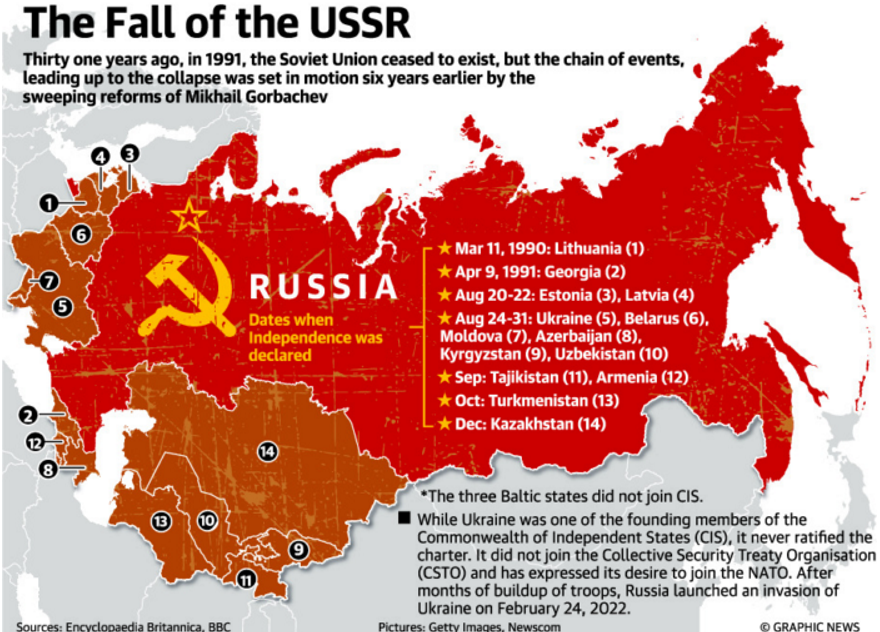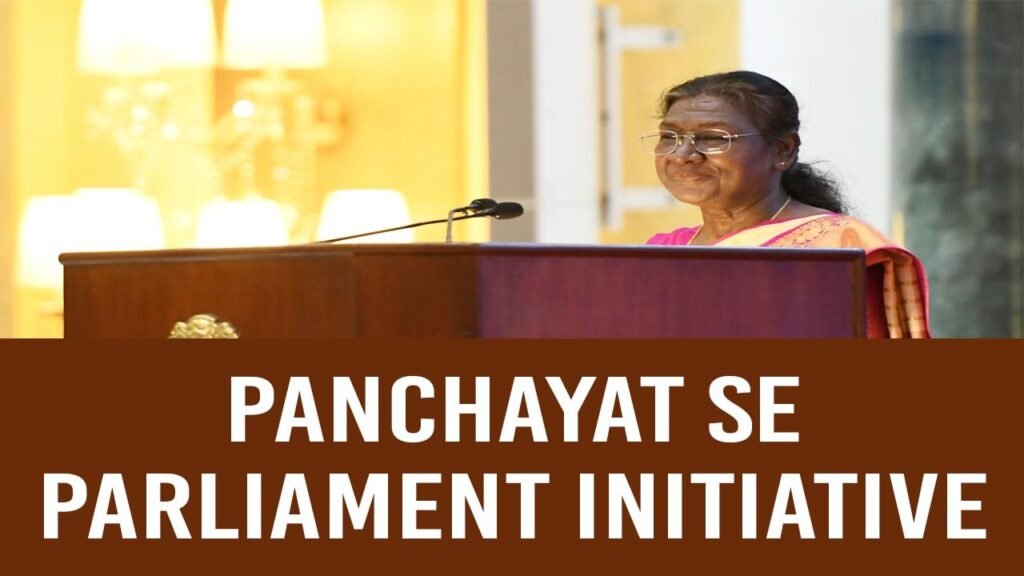
Disintegration of the Soviet Union
Why in News?
- 25th December marked the anniversary of the disintegration of the Soviet Union, commemorating the day in 1991 when the Soviet flag was taken down from the Kremlin, symbolizing the official end of the USSR.
Overview of the Soviet Union (USSR):
- Officially called the Union of Soviet Socialist Republics (USSR), it was a socialist federation from 1922 to 1991, comprising multiple republics, with Russia as the dominant power.
- Governed by the Communist Party, it played a pivotal role in 20th-century global geopolitics, particularly during the Cold War era.
Formation of the Soviet Union:
Historical Context:
- Tsarist Regime and Monarchy: The USSR traces its origins to the Russian Revolution of 1917, which ended the 300-year rule of the Romanov dynasty (1613-1917).
- The Tsar’s absolute power over governance, military, and society created deep dissatisfaction, exacerbated by rising inequality and economic hardship.
Key Events Leading to the Formation:
- February Revolution (1917):
- Protests and strikes led to Tsar Nicholas II’s abdication and the end of monarchy.
- A Provisional Government took charge but faced challenges from the Petrograd Soviet, dominated by socialist factions like the Bolsheviks and Mensheviks.
- October Revolution (1917):
- Led by Lenin and Trotsky, the Bolsheviks overthrew the Provisional Government and declared “All power to the Soviets.”
- This marked the establishment of Soviet rule and the beginning of communist policies such as nationalization.
- Russian Civil War (1918-1922):
- The Red Army, led by Bolsheviks, fought against the anti-Bolshevik forces (White Guards) during the Civil War.
- The Bolsheviks emerged victorious, consolidating power and paving the way for a unified state.
- Formation of the USSR (30th December 1922):
- The Union of Soviet Socialist Republics (USSR) was officially established, becoming the world’s first communist state.
- Lenin’s leadership introduced centralized economic planning and communist governance.
Key Developments in the Soviet Union:
Leadership Transitions:
- From Lenin’s Bolshevik consolidation to Stalin’s centralization and the Great Purge (1936), the USSR’s leadership evolved through key events:
- Soviet victory over Nazi Germany in World War II.
- Khrushchev’s reforms, Brezhnev’s stability, and Gorbachev’s restructuring efforts.
World War II and Lithuania (1940s):
- The Baltic States (“Estonia, Latvia, and Lithuania”) were forcibly incorporated into the USSR in 1940 under the Molotov–Ribbentrop Pact.
- These states had earlier gained independence in 1918 after the collapse of the Russian Empire.
Post-War Superpower Status:
- Post-World War II, the USSR emerged as a superpower, forming the Warsaw Pact and leading the socialist bloc during the Cold War.
Reasons for the Disintegration of the USSR:
Economic Stagnation:
- By the 1970s, the Soviet economy suffered from low productivity and outdated technology.
- Overemphasis on military expenditure and financial support for satellite states drained resources.
- Despite state subsidies, citizens faced consumer shortages and rising dissatisfaction.
Gorbachev’s Reforms:
- Glasnost (openness) and Perestroika (restructuring) aimed to reform the economy and governance but weakened the Communist Party’s control.
- Multi-party elections (1990) and reduced censorship fueled nationalist movements in republics like Lithuania and Ukraine.
Cold War Pressures:
- The arms race with the US, defeat in Afghanistan, and the fall of the Berlin Wall (1989) further eroded Soviet control.
- The inability to compete with Western economic models magnified internal inefficiencies.
Nationalist Movements and Secession:
- Russian nationalism, led by Yeltsin, weakened central authority.
- Baltic states, Ukraine, and other republics sought independence.
- By December 1991, the USSR dissolved into independent states, ending the bipolar global order.
Impact of the Soviet Collapse on Global Power Dynamics:
Emergence of a Unipolar World Order:
- The disintegration of the USSR ended the Cold War, leaving the US as the sole superpower.
- NATO expanded eastward, integrating former Soviet bloc nations like Poland and the Baltic states.
Global Capitalism:
- Western institutions like the IMF and World Bank promoted free-market reforms in former socialist states.
- Eastern Europe’s integration into the European Union reinforced US-led global hegemony.
Regional Power Shifts:
- The collapse allowed nations like China and India to assert themselves in global geopolitics.
- Central Asian republics emerged as strategic players, balancing ties with Russia, China, and the West.
Legacy of the Soviet Union’s Collapse:
Ongoing Conflicts and Nationalism:
- Russia-Ukraine Conflict:
- Russia’s annexation of Crimea (2014) and the ongoing war reflect its attempt to reclaim Soviet-era influence.
- Armenia-Azerbaijan Conflict:
- The conflict over Nagorno-Karabakh stems from Stalin’s 1923 decision to transfer the region to Azerbaijan, despite its majority Armenian population.
- Kosovo-Serbia Dispute:
- Kosovo’s 2008 independence from Serbia remains unrecognized by several nations, contributing to Balkan instability.
NATO Expansion:
- NATO’s eastward growth is seen by Russia as a direct threat, fueling geopolitical tensions.
Energy and Geopolitics:
- Without the Soviet Union’s communist ideology, Russia relies on oil, gas, and defense exports to exert influence, especially in Europe.
Impact on India:
- Economic Diversification:
- The collapse disrupted India’s trade with the USSR, leading to economic liberalization (1991) and efforts to attract foreign investment.
- Defense Ties:
- India transitioned to joint production of defense equipment, such as the BrahMos missile, reducing reliance on imports.
- Partnerships expanded to include US, France, and Israel.
- Geopolitical Realignment:
- India balanced ties with Russia while engaging in US-led initiatives like the Quad.
- Membership in organizations like BRICS and SCO reinforced India’s strategic autonomy.
- Cultural and Scientific Cooperation:
- Soviet-era cultural exchanges and collaborations in space technology and nuclear energy strengthened bilateral relations.
Conclusion:
The disintegration of the Soviet Union marked a turning point in global history. It ended the Cold War, shifted the global power balance, and reshaped international relations. For India, it led to economic liberalization and a realignment of geopolitical strategies. Today, the legacy of the USSR’s collapse continues to influence regional conflicts and global geopolitics, making it a critical topic for students preparing for competitive exams.


